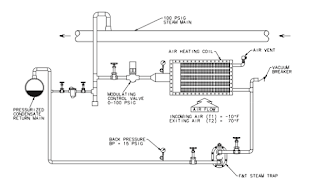 |
| Heat transfer loop |
Stall occurs primarily in heat transfer equipment where the steam pressure is modulated to obtain a desired output (i.e. product temperature). The pressure range of any such equipment ( coils, shell & tube, etc....) can be segmented into two (2) distinct operational modes, Operating and Stall.
Operating: In the upper section of the pressure range the operating pressure (OP) of the equipment is greater than the back pressure (BP) present at the discharge of the steam trap. Therefore a positive pressure differential across the trap exists allowing for condensate to flow from the equipment to the condensate return line.
Stall: In the lower section of the pressure range the operating pressure (OP) of the equipment is less than or equal to the back pressure (BP) present at the discharge of the steam trap. Therefore a negative or no pressure differential exists, this does not allow condensate to be discharged to the return line and the condensate begins to collect and flood the equipment.
You can read the entire Armstrong technical paper below.
Visit this link to download your own copy of Armstrong Fluid Handling: Understanding and Solving Equipment Stall.